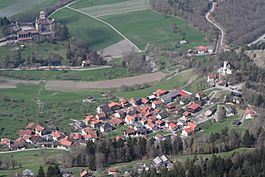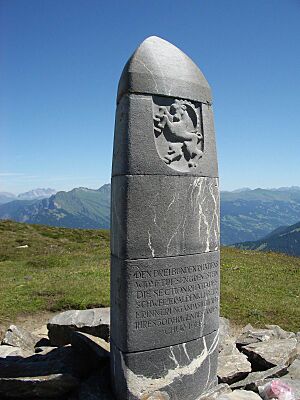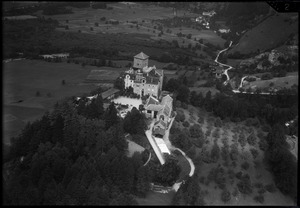Tomils facts for kids
Quick facts for kids
Tomils
|
||
|---|---|---|
 |
||
|
||
| Country | Switzerland | |
| Canton | Graubünden | |
| District | Hinterrhein | |
| Area | ||
| • Total | 30.56 km2 (11.80 sq mi) | |
| Elevation | 801 m (2,628 ft) | |
| Population
(Dec 2013)
|
||
| • Total | 717 | |
| • Density | 23.462/km2 (60.77/sq mi) | |
| Postal code |
7418
|
|
Tomils was once a small town, also known as a municipality, located in the Swiss canton of Graubünden. It was part of the Hinterrhein district.
Tomils was created on January 1, 2009, when four smaller towns — Feldis/Veulden, Scheid, Trans, and Tumegl/Tomils — joined together. Later, on January 1, 2015, Tomils and four other towns (Almens, Paspels, Pratval, and Rodels) merged again. They formed a new, larger municipality called Domleschg.
Contents
People of Tomils
As of 2013, Tomils had a population of 717 people. This means that 717 individuals lived in the area that was then known as Tomils.
The Dreibündenstein Marker
The Dreibündenstein is a special stone marker. Its name means "Three Leagues Stone" in German. In the Romansh language, it's called Term bel. This marker shows the exact spot where the borders of three important historical groups met. These groups were the League of God's House, the League of the Ten Jurisdictions, and the Grey League. These three groups eventually came together to create the modern canton of Graubünden.
Location and Height
The Dreibündenstein is located high up in the mountains. It sits at an elevation of about 2,160 meters (which is about 7,087 feet) above sea level. You can find it on the border where the towns of Domat/Ems, Scheid (which is now part of Tomils), and Malix meet.
History of the Stone
The very first Dreibündenstein was placed in 1722. This original stone is now kept safe in the Rätian Museum in Chur. In 1742, a writer named Nicolin Sererhard mentioned that there were actually three stones marking this important spot.
The stone marker you see today was built in 1915 by a group called the Sektion Rhätia (Rhätian Section) of the Swiss Alpine Club. It stands about 2 meters (or 6 feet 7 inches) tall. To make it easier for people to visit this historical marker, a chairlift was added to the mountain in 1970.
See also
 In Spanish: Tomils para niños
In Spanish: Tomils para niños






